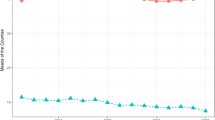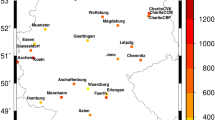Abstract
Adverse birth outcomes are associated with exposure to air pollution during pregnancy. Road proximity is a simple, widely available metric for capturing local variation in exposure to traffic-related air pollution. We characterized maternal exposure to traffic-related air pollution during pregnancy using residential proximity to major roadways among 2004–2008 singleton births in NC. Controlling for maternal race, age, education, nativity, marital status, and tobacco use, and season of birth, parity, infant sex, and Census tract-level urbanization and income, we evaluated the association between road proximity and pregnancy outcomes using generalized linear mixed models with a random intercept for each Census tract. Birth weight, birth weight percentile for gestational age, gestational hypertension, and small-for-gestational age were not associated with road proximity; however, women residing within 250 m of a major roadway were at 3–5% increased odds of low birth weight, preterm birth, and late preterm birth compared with women residing beyond 250 m (P<0.05). Our analyses demonstrate an association between proximity to major roadways and pregnancy outcomes using a large sample. Road proximity may represent a relatively straightforward method for assessing maternal risk from exposure to traffic-related air pollution, with results offering guidance for studies that can more accurately characterize air pollution exposures.
This is a preview of subscription content, access via your institution
Access options
Subscribe to this journal
Receive 6 print issues and online access
$259.00 per year
only $43.17 per issue
Buy this article
- Purchase on Springer Link
- Instant access to full article PDF
Prices may be subject to local taxes which are calculated during checkout

Similar content being viewed by others
References
Brunekreef B., and Holgate S.T. Air pollution and health. Lancet 2002: 360 (9341): 1233–1242.
Jerrett M., Arain A., Kanaroglou P., Beckerman B., Potoglou D., Sahsuvaroglu T., et al. A review and evaluation of intraurban air pollution exposure models. J Expo Anal Environ Epidemiol 2005: 15 (2): 185–204.
Sram R.J., Binkova B., Dejmek J., and Bobak M. Ambient air pollution and pregnancy outcomes: a review of the literature. Environ Health Perspect 2005: 113 (4): 375–382.
Hack M., Klein N.K., and Taylor H.G. Long-term developmental outcomes of low birth weight infants. Future Child 1995: 5 (1): 176–196.
Moster D., Lie R.T., and Markestad T. Long-term medical and social consequences of preterm birth. N Engl J Med 2008: 359 (3): 262–273.
Barker D.J. The intra-uterine origins of disturbed cholesterol homeostasis. Acta Paediatr 1999: 88 (5): 483–484.
Barker D.J., Martyn C.N., Osmond C., Hales C.N., and Fall C.H. Growth in utero and serum cholesterol concentrations in adult life. BMJ 1993: 307 (6918): 1524–1527.
Osmond C., Barker D.J., Winter P.D., Fall C.H., and Simmonds S.J. Early growth and death from cardiovascular disease in women. BMJ 1993: 307 (6918): 1519–1524.
Weiss J.L., Malone F.D., Emig D., Ball R.H., Nyberg D.A., Comstock C.H., et al. Obesity, obstetric complications and cesarean delivery rate — a population-based screening study. Am J Obstet Gynecol 2004: 190 (4): 1091–1097.
Damaceno-Rodrigues N.R., Veras M.M., Negri E.M., Zanchi A.C., Rhoden C.R., Saldiva P.H., et al. Effect of pre- and postnatal exposure to urban air pollution on myocardial lipid peroxidation levels in adult mice. Inhal Toxicol 2009: 21 (13): 1129–1137.
Fedulov A.V., Leme A., Yang Z., Dahl M., Lim R., Mariani T.J., et al. Pulmonary exposure to particles during pregnancy causes increased neonatal asthma susceptibility. Am J Respir Cell Mol Biol 2008: 38 (1): 57–67.
Auten R.L, Gilmour M.I., Krantz Q.T., Potts E.N., Mason S.N., and Foster W.M. Maternal diesel inhalation increases airway hyperreactivity in ozone exposed offspring. Am J Respir Cell Mol Biol 2011: 46 (4): 454–460.
Veras M., Damaceno-Rodrigues N., Caldini E., Maciel Ribeiro A., Mayhew T., Saldiva P., et al. Particulate urban air pollution affects the functional morphology of mouse placenta. Biol Reprod 2008: 79 (3): 578–584.
Rocha E., Silva I., Lichtenfels A.J., Amador Pereira L.A., and Saldiva P.H. Effects of ambient levels of air pollution generated by traffic on birth and placental weights in mice. Fertil Steril 2008: 90 (5): 1921–1924.
Mauad T., Rivero D., de Oliveira R., Lichtenfels A., Guimaraes E., de Andre P., et al. Chronic exposure to ambient levels of urban particles affects mouse lung development. Am J Respir Crit Care Med 2008: 178 (7): 721–278.
Wenzel S., and Holgate S.T. The mouse trap: it still yields few answers in asthma. Am J Respir Crit Care Med 2006: 174 (11): 1173–1176.
van den Hooven E.H., Jaddoe V.W., de K.Y., Hofman A., Mackenbach J.P., Steegers E.A., et al. Residential traffic exposure and pregnancy-related outcomes: a prospective birth cohort study. Environ Health 2009: 8: 59.
Genereux M., Auger N., Goneau M., and Daniel M. Neighbourhood socioeconomic status, maternal education and adverse birth outcomes among mothers living near highways. J Epidemiol Community Health 2008: 62 (8): 695–700.
Wilhelm M., and Ritz B. Residential proximity to traffic and adverse birth outcomes in Los Angeles county, California, 1994–1996. Environ Health Perspect 2003: 111 (2): 207–216.
Yang C.Y., Chang C.C., Chuang H.Y., Ho C.K., Wu T.N., and Tsai S.S. Evidence for increased risks of preterm delivery in a population residing near a freeway in Taiwan. Arch Environ Health 2003: 58 (10): 649–654.
Yorifuji T., Naruse H., Kashima S., Ohki S., Murakoshi T., Takao S., et al. Residential proximity to major roads and preterm births. Epidemiology 2011: 22 (1): 74–80.
Brauer M., Lencar C., Tamburic L., Koehoorn M., Demers P., and Karr C. A cohort study of traffic-related air pollution impacts on birth outcomes. Environ Health Perspect 2008: 116 (5): 680–686.
Zeka A., Melly S.J., and Schwartz J. The effects of socioeconomic status and indices of physical environment on reduced birth weight and preterm births in Eastern Massachusetts. Environ Health 2008: 7: 60.
US Census Bureau. 2006 Second Edition TIGER/Line Files. US Census Bureau, Washington, DC, 2007.
US Census Bureau. 2006 Second Edition TIGER/Line Technical Documentation. US Census Bureau, Washington, DC, 2007.
North Carolina Department of Transportation, Traffic Survey Group. AADT Traffic Volume Reports. http://www.ncdot.gov/doh/preconstruct/tpb/traffic_survey (last updated 2012).
Karner A.A., Eisinger D.S., and Niemeier D.A. Near-roadway air quality: synthesizing the findings from real-world data. Environ Sci Technol 2010: 44 (14): 5334–5344.
US Census Bureau. Census 2000 Summary File 3--NC. US Census Bureau, Washington, DC, 2002.
Brook J.R., Poirot R.L., Dann T.F., Lee P.K., Lillyman C.D., and Ip T. Assessing sources of PM2.5 in cities influenced by regional transport. J Toxicol Environ Health A 2007: 70 (3–4): 191–199.
Diem J.E., and Comrie A.C. Predictive mapping of air pollution involving sparse spatial observations. Environ Pollut 2002: 119 (1): 99–117.
Ryan P.H., and Lemasters G.K. A review of land-use regression models for characterizing intraurban air pollution exposure. Inhal Toxicol 2007: 19 (Suppl 1): 127–133.
The Green Book Nonattainment Areas for Criteria Pollutants. http://www.epa.gov/oaqps001/greenbk/index.html (last updated 30 August 2011).
Acknowledgements
This research was supported by funding for the Southern Center on Environmentally-Driven Disparities in Birth Outcomes provided by the US Environmental Protection Agency (RD-83329301).
Author information
Authors and Affiliations
Corresponding author
Ethics declarations
Competing interests
The authors declare no conflict of interest.
Rights and permissions
About this article
Cite this article
Miranda, M., Edwards, S., Chang, H. et al. Proximity to roadways and pregnancy outcomes. J Expo Sci Environ Epidemiol 23, 32–38 (2013). https://doi.org/10.1038/jes.2012.78
Received:
Accepted:
Published:
Issue Date:
DOI: https://doi.org/10.1038/jes.2012.78
Keywords
This article is cited by
-
Air Pollution and Racial Disparities in Pregnancy Outcomes in the United States: A Systematic Review
Journal of Racial and Ethnic Health Disparities (2024)
-
Toll-like Receptor 4 Pathway Polymorphisms Interact with Pollution to Influence Asthma Diagnosis and Severity
Scientific Reports (2018)
-
Mapping outdoor habitat and abnormally small newborns to develop an ambient health hazard index
International Journal of Health Geographics (2017)
-
Hispanic health in the USA: a scoping review of the literature
Public Health Reviews (2016)
-
Assessing the impact of race, social factors and air pollution on birth outcomes: a population-based study
Environmental Health (2014)



